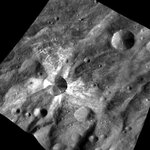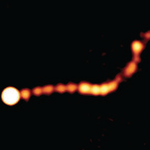Space

A new image of supernova remnant W44, which combines far-infrared and X-ray data from ESA’s Herschel and XMM-Newton space observatories, shows the aftershock of a stellar explosion rippling through space. W44 is about 10,000 light-years away, in the dense star-forming clouds of the constellation of Aquila, the Eagle, and is one of the best examples of a supernova remnant interacting with its parent molecular cloud.
All that remains of the stellar behemoth is the spinning core of a neutron star, or pulsar. Identified as PSR B1853+01, the pulsar is the bright point to the top left in W44,…

Astronomers have identified a body that is very probably a planet wandering through space - without a parent star. This is the closest such object to oue Solar System, a distance of about 100 light-years and its comparative proximity and the absence of a bright star very close to it have allowed the team to study its atmosphere in great detail.
Free-floating planets are planetary-mass objects that roam through space without any ties to a star. Possible examples of such objects have been found before but without knowing their ages, it was not possible for astronomers to know…

We're not that special, says new research led by the Centre for Star and Planet Formation at the Natural History Museum of Denmark, University of Copenhagen.
About 4.567 billion years ago, our solar system's planets spawned from an expansive disc of gas and dust rotating around the sun. While similar processes are witnessed in younger solar systems throughout the Milky Way, the formative stages of our own solar system were believed to have taken twice as long to occur. It turns out that is not the case, according to a new paper.
Using improved methods of analysis of uranium and lead…

Solar systems with life-bearing planets are, so far, unique. There is only one. But they would be rare anyway, if they are dependent on the presence of asteroid belts of just the right mass, according to two US astronomers.
Rebecca Martin, a NASA Sagan Fellow from the University of Colorado and astronomer Mario Livio of the Space Telescope Science Institute in Baltimore suggest that the size and location of an asteroid belt, shaped by the evolution of the Sun's protoplanetary disk and by the gravitational influence of a nearby giant Jupiter-like planet, may determine whether…

The giant asteroid Vesta is constantly stirring its outermost layer, according to data from NASA's Dawn mission that show that a form of weathering that occurs on the moon and other airless bodies we've visited in the inner solar system does not alter Vesta's outermost layer in the same way.
Carbon-rich asteroids have also been splattering dark material on Vesta's surface over a long span of the body's history. Over time, soils on Earth's moon and asteroids such as Itokawa have undergone extensive weathering in the space environment. Scientists see this in the accumulation of tiny metallic…

Does the nearby star Fomalhaut host a massive exoplanet? It depends on who you ask.
A new paper says that the planet, named Fomalhaut b, is a rare and possibly unique object that is completely shrouded by dust. Wasn't it already a planet?
Yes and no. It was there, then it wasn't and now it may be 'back from the dead'. The original study reported that Fomalhaut b's brightness varied by about a factor of two and cited this as evidence that the planet was accreting gas. Follow-up studies interpreted that variability as evidence that the object actually was a transient dust cloud…

When is a theory not a theory? When no one can even agree on what the theory is and competing ones are disproved once a year. Astronomers disagree about why they see more light in the universe than should be seen; that is, why the infrared light they observe exceeds the amount of light emitted from known galaxies.
When looking at the cosmos, astronomers have seen what are neither stars nor galaxies nor a uniform dark sky but mysterious, sandpaper-like smatterings of light, what UCLA professor of physics and astronomy Edward L. (Ned) Wright refers to as "fluctuations".
The debate…

Alpha Centauri is the closest star system to Earth other than our own sun. So one would think if it had planets, we would know by now, right? Wrong, apparently. Astronomers just announced the discovery of an Earth-sized planet in Alpha Centauri, although it's closer to its star than Mercury is to our sun, so unlikely to have life. However, there may actually be even more planets further out from the star! So why are we only just now discovering planets in our nearest neighboring solar system, and why don't we know yet if there are more?
Two reasons: planetary…

International astronomical photographers have created a catalog of over 84 million stars in the central parts of the Milky Way; 10X more stars than previous catalogs and a great leap forward in making some sense of our home galaxy. The image gives viewers an incredible, zoomable view of the central part of our galaxy. It is so large that, if printed with the resolution of a typical book, it would be 9 yards long and 7 yards high
Most spiral galaxies, including our Milky Way, have a large concentration of ancient stars surrounding the center that astronomers call 'the bulge'. Understanding the…

Blasting over two million lights years from the center of a distant galaxy, PKS 0637-752 is a 'supersonic jet' of material that looks a lot like the afterburner flow of a fighter jet - but in this case the jet engine is a supermassive black hole and the jet material is actually moving at closer to the speed of light.
This megaparsec, galaxy-scale jet has bright and dark regions, similar to the phenomenon in afterburner exhaust called ‘shock diamonds.’ This new image of the previously studied jet reveals regularly spaced areas that are brighter than the rest of the jet in a pattern that…